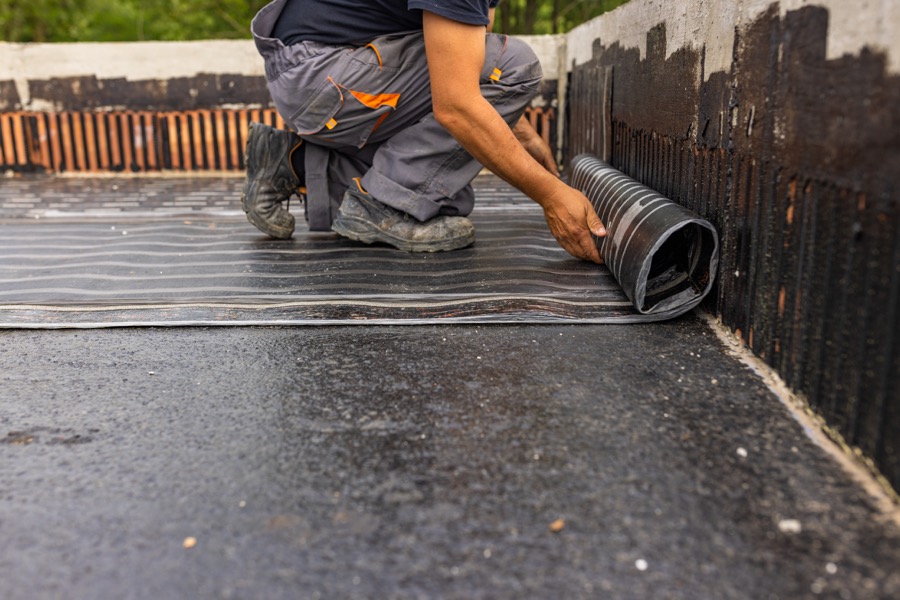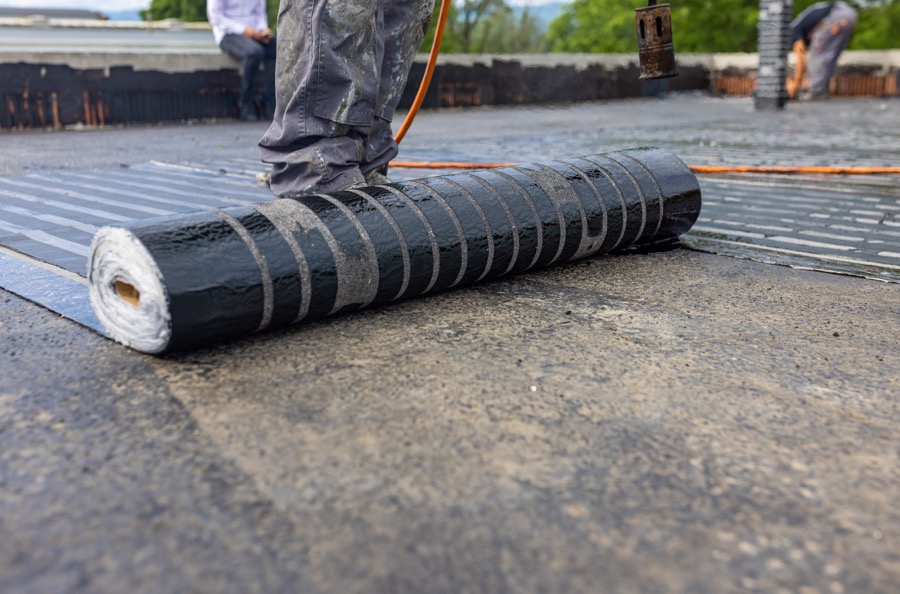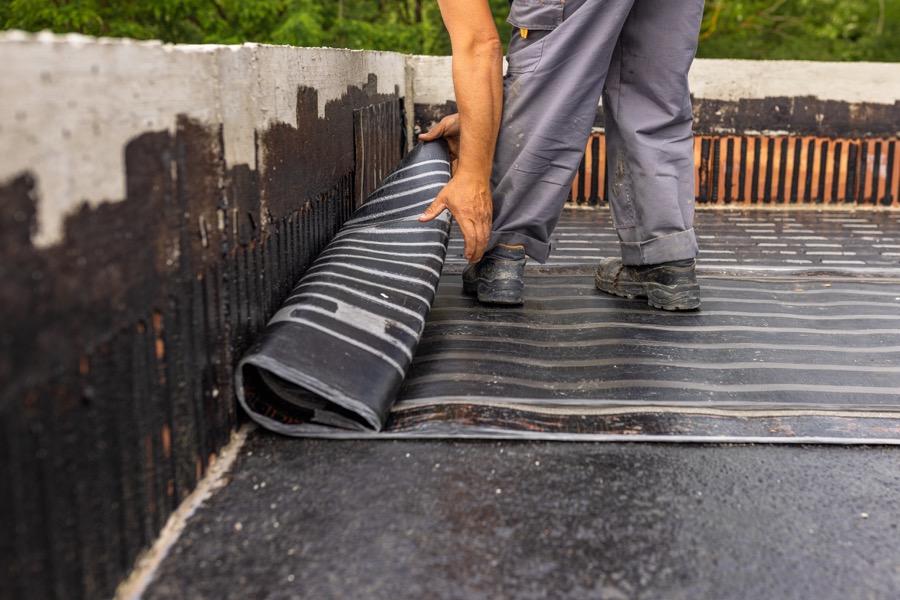
Home > Blog posts > A vapor barrier, an efficient way to protect your roof
A vapor barrier, an efficient way to protect your roof
The insulation system on a roof is crucial in order to ensure the durability of your structure. No matter if you own a house or a building, the vapor barrier is an important component, allowing you to prevent humidity from forming.
Clinique de la toiture FCA tells you more about the importance of a vapor barrier on your roof and how to install it according to current standards and regulations.
What is a vapor barrier and why is so it important?
We know that we are not providing you with any new information by telling you that insulation is an essential part of a building or a house’s structure. Among the elements that contribute to proper insulation, a vapor barrier is a must; but what is it exactly?
It usually takes the shape of a sheet, generally plastic or metal. It is designed to protect your house and its structure from water vapor.
The vapor barrier is installed within the walls, but can also be installed on the ceiling, in the floors and the roof. It plays an important role, that of preventing condensation from forming within the structure, condensation caused by the contrasts of hot and cold air coming from the interior and the exterior.
Why install a vapor barrier? Preventing condensation means avoiding all problems created by humidity, including rot and mold, and which can reach your building’s structure and cause significant damages.
A vapor barrier on your roofing will also protect your roof’s structure. It is a rather affordable component that can help you save big on potential damage related costs!
The vapor barrier is first and foremost used as protection, but it also presents other advantages. In fact, it will also allow you to be more energy efficient by reducing heat loss, given how it contributes to your building’s insulation.
This means that it reduces losses from heating or air-conditioning, which in turn provides you with a more comfortable interior space.

How are vapor barriers installed?
Although the name itself reminds us of an air-barrier, the vapor barrier is installed differently. However, when it is installed properly and watertight, it can do both at once!
As we have mentioned, the vapor barrier can be installed within the walls, the ceilings, the floors and the roof. In any case, a vapor barrier must be installed between the insulation and the drywall (or dry partition). It is placed on the heated side of the wall or partition.
It the attic, it can also be placed on the floor in order to protect the roof structure. In this case, it is important that the vapor barrier come up the sides of the roof walls in order to ensure that it is waterproof.
Before installing the vapor barrier, make sure you have all of the necessary tools:
- The vapor barrier
- And acoustic sealant
- Special tape made for vapor barriers
- Scissors and a measuring tool
If necessary, clean the surface on which you are installing the vapor barrier: it must be intact and clean, but also –and mostly- dry.
You can then begin cutting the vapor barrier according to the size of the area you are covering. If you are installing it in a wall, you will obviously have to cut openings for the doors and windows.
In order to stick the vapor barrier onto the structure, you must first apply acoustic sealant. You can then stick the vapor barrier onto the area you wish to cover.
Finally, you will want to seal the joints with tape that is specially made for vapor barriers, as this will ensure that it is watertight.

The materials used to make a vapor barrier
Several materials can be used to make a vapor barrier. However, the one most used in the province of Quebec is polyethylene. This plastic membrane has the advantage of being affordable, easy to install, on top of being efficient.
Other materials, however, can also be used as vapor barriers like, for example:
- Elastomer coated layers
- Aluminum sheets
- Metallic sheets
- Vapor retarding paints
- Exterior grade plywood
On a flat roof, two types of materials are generally used. The first category consists of bituminous vapor barriers or membranes, which are a mixture of asphalt and felt or fiberglass.
The second –as you have probably already guessed- are non-bituminous vapor barriers, among which you will find the materials abovementioned. This includes all types of plastic, laminate or aluminum membranes.
Warning: all materials are not equal! Some offer different levels of waterproofness, which is an important factor to take into consideration.
The choice of materials will thus depend on the climate; here in Quebec, the climate is rather cold. This means that materials with a good permeability rating are necessary. An area that is warmer won’t have the same needs when it comes to insulation and vapor barriers. The key is to choose a material that is adapted to your area.
Hardware stores or retailers offer materials that are adapted to your climate; they can also help you in your selection by, for example, telling you if a vapor barrier is adequate for your roof. This information is also more generally accessible in the product’s specs.

Mistakes to avoid during installation
The very first mistake to avoid would –obviously- be to not install a vapor barrier! If you are still reading this article, chances are you probably already understand how important it is.
The choice of materials is also very important: choosing the wrong vapor barrier is a mistake that must be avoided before even proceeding to the installation. This, however, is not the only mistake you can make. A vapor barrier that is not properly installed can lead to several consequences; here are the main mistakes you should avoid.
Firstly, it is important to place the vapor barrier where it is meant to be installed, which means between the insulation and the drywall. If, for example, you were to place the vapor barrier between two types of insulation, you could be making your situation worse. In fact, this is the perfect way to encourage the accumulation of humidity in your structure!
It is important to install the vapor barrier on the heated side of the insulating surface. On the roof, this means that the vapor barrier will be installed last, while for an attic floor, the opposite is true.
If you do not have a thorough understanding of the different components that make up a structure, it might be better for you to trust in professionals for construction and renovation needs. A vapor barrier that is not properly installed can do more harm than good.
When installing a vapor barrier, it is also important to ensure not to damage it. A barrier with holes is an excellent way to allow humidity to circulate, which would render all of your efforts useless. If you should notice a tear, no need to worry; simply cover it with tape specially made for your vapor barrier.
Moreover, another mistake to avoid is using the wrong kind of tape. Do not use duct tape; the specialized tape for your vapor barrier is also called tuck tape. It is a high-quality tape that resists to air and humidity infiltrations, among other things.

Rules and regulations for your vapor barrier
The National Building Code has established certain rules and regulations regarding vapor barriers. Firstly, the 9.25.4.1. section states that “thermally insulated wall, ceiling and floor assemblies shall be constructed with a vapour barrier”. It is mandatory in order to prevent water vapor from entering the empty spaces within the walls, floors and roof.
The following section also specifies certain standards that must be respected when selecting a vapor barrier:
A maximum permeability of 60 ng/(Pa.s.m2)
- Polyethylene vapor barrier membranes must comply to CAN/CGSB-51.34-M standards
- Membranes that are not made from polyethylene must comply to CAN/CGSB-51.33-M standards
When it comes to membranes that are not made from polyethylene, they must sometimes be covered or installed in areas that are not exposed to UV rays. This is the case for materials that risk deterioration when exposed to ultraviolet rays.
As mentioned above, coatings or paints can also be used as vapor barriers. However, they must comply to CAN/CGSB-1.501-M standards.
Finally, the 9.25.4.3. section of the National Building Code specifies that vapor barriers must be installed on the heated side. The insulation and vapor barrier can be combined in a single product or be two separate products.
In the case of two separate products, you must ensure that the vapor barrier be close enough to the heated side of the insulation material so as to prevent condensation from forming. The same rule applies when a product serves both as a vapor barrier and insulation.

The consequences of choosing the wrong vapor barrier
As we have mentioned above, the choice of a vapor barrier must be adapted to the climate. This is why it is essential to follow the rules and regulations established by the National Building Code.
A bad choice of vapor barrier can create the exact opposite of what you are looking for, in the long term, which means that it would encourage the formation of condensations in your roof structure or walls instead of preventing it. Do not hesitate to ask professionals for help!
For any other question concerning your flat roof, or for any repairs, renovations or even a new construction, contact us at Clinique de la toiture FCA. Our team of passionate experts are here to ensure optimal insulation!
Need help?
Leave us your email address and we will contact you as soon as possible to assess your needs!
Put an end to your water infiltration your clogged drains your roof problems
Leave us your email address and we will contact you as soon as possible to assess your needs!
